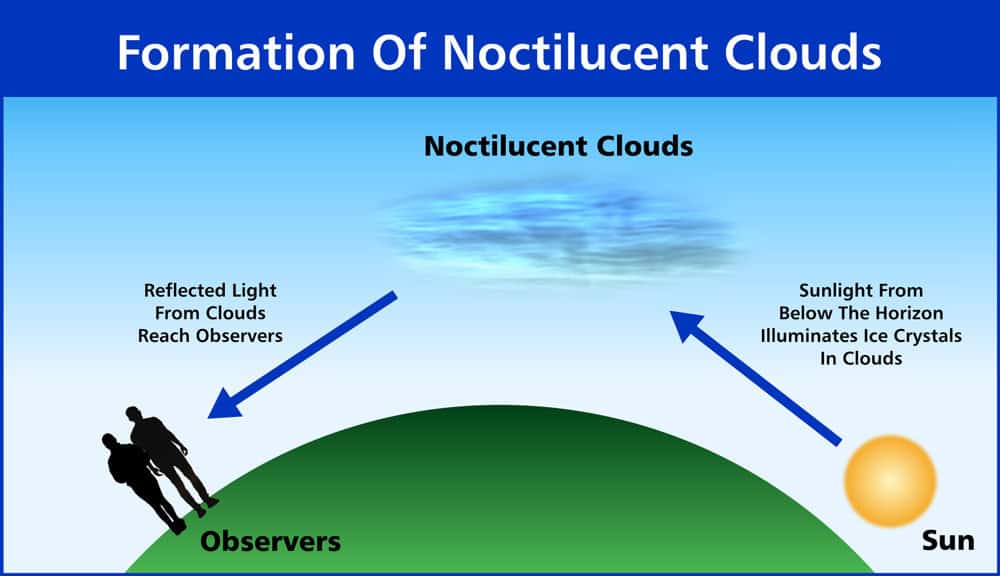Noctilucent Clouds: Defining Night Shining Clouds And How They Form
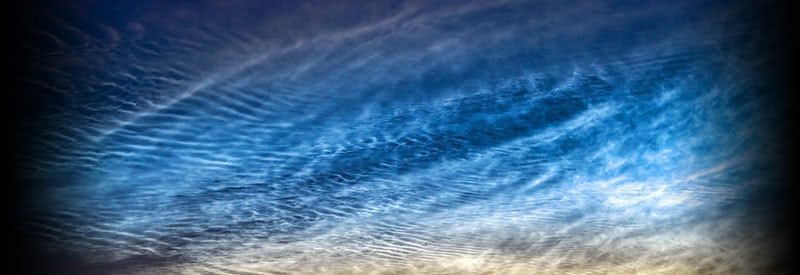
Certain cloud formations can result in some of the most awe-inspiring and spectacular events nature occasionally puts on display. We look at one such meteorological phenomenon known as Noctilucent clouds.
Noctilucent clouds are defined as high-level clouds forming after sunset at an altitude of approximately 80 km or 50 miles. Also known as night-shining clouds, they occur when sunlight below the horizon illuminates and reflects off ice crystals in the mesosphere, resulting in a blue or silver hue.
These cloud formations are not nearly as common as more familiar cloud types and can mostly be viewed at high latitudes during the summer months (during May-August in the Northern Hemisphere and during November-February in the Southern Hemisphere).
They are, however, of no less importance or any less spectacular. In fact, noctilucent clouds are often used by meteorologists to study wind movement in the upper atmosphere.
In this article, we take a closer look at the definition of noctilucent clouds, how they form, as well as the characteristics that define them.
What Are Noctilucent Clouds?
In order to understand how and why noctilucent clouds form and why they exhibit the characteristics that define them, one needs a more expansive and detailed definition of what precisely this cloud formation is:
Noctilucent Cloud Definition
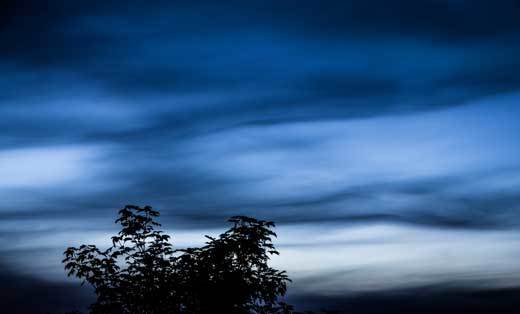
Noctilucent clouds are high-level clouds that form after sunset (during astronomical twilight) at an altitude of approximately 76 - 85 km (47 - 53 miles) in the mesosphere.
Also known as night shining or polar mesospheric clouds, they occur when the sunlight illuminates & reflects off ice crystals in the upper atmosphere, which results in the characteristic illuminated blue or silver color.
They can mostly be observed at high latitudes during the summer months (May-August in the Northern Hemisphere and November-February in the Southern Hemisphere).
The name "noctilucent" is derived from Latin words "nocto" and "lucent," which translates to "night shining" (A direct reference to the radiant characteristics of this cloud formation.)
Noctilucent clouds are also more commonly known as night shining clouds or polar mesospheric clouds. Their structure closely resembles the streaky or flaky characteristics of Cirrus clouds (another high-level cloud type).
They occur at an altitude of 76 - 85 km (47 - 53 miles) in the mesosphere, where it is too cold for water to remain in its liquid state, and ice crystals form on small dust particles, which are believed to be remains of meteors. (Meteors burn up in the mesosphere.)
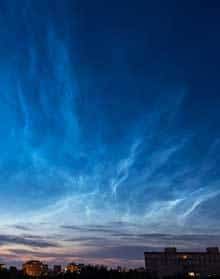
The clouds are too faint to be visible during the day and only become visible after sunset when the sky is mostly covered in darkness. This allows ice crystals in the high-level noctilucent clouds that are still exposed to the sunlight to be illuminated.
Noctilucent clouds are typically observed at high latitudes (approximately 50 to 70 degrees north or south) since this is where temperatures in the mesosphere drop to below -120° Celsius (-184° Fahrenheit), which is a necessary condition for the clouds to form.
An observer located at a high latitude on the planet's surface can view the illuminated phenomenon as cirrus-like cloud formations with a blue or silver hue.
(The blue color is a result of the absorption of ozone in the atmosphere.)
As the definition already eluded to, this cloud type is a fairly rare meteorological occurrence. The reason for this is the restrictive conditions that need to be in place for them to form and also be observed in the first place. We discuss them in the next section.
How Noctilucent Clouds Form
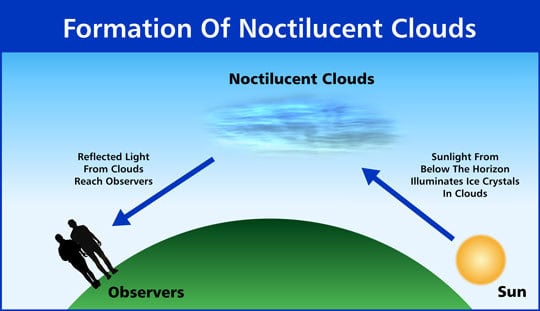
Diagram illustrating the formation of noctilucent clouds. Click on the image for a larger, more detailed view.
Noctilucent clouds are rare meteorological phenomena for a reason. The strict conditions necessary for their development only occur at certain latitudes & during specific times of the year. Noctilucent cloud formation occurs as follows, starting with the necessary conditions:
- 1Temperatures in the mesosphere need to be below -120° Celsius (-184° Fahrenheit) for noctilucent clouds to form.
- 2This means the clouds can only form during the summer (when solar radiation forces warm air to rise higher into the atmosphere and cool down further, resulting in the colder air in the mesosphere).
- 3For the same reason, an observer must also be located at a high latitude (approximately 50 to 70 degrees north or south), the location where temperatures in the mesosphere drop low enough.
- 4From an observer's perspective, the sun also needs to be below the horizon to allow a large portion of the sky to be covered in darkness. (Noctilucent clouds appear very faint and are impossible to view in daylight.)
- 5If enough water vapor and dust particles are present in the air, noctilucent clouds form in the subzero temperatures.
- 6Although the observer is already covered in darkness, sunlight from below the horizon still reaches the high-level noctilucent clouds situated at an altitude of approximately 80 km (50 miles).
- 7As a result, the sunlight illuminates the ice crystals in the clouds, which light is reflected back to the observer at the surface.
- 8The observer at the surface views the noctilucent clouds as cirrus-like clouds with a blue or silver hue.
There are also other processes involved in the formation of noctilucent clouds, but this section highlighted the key steps involved in the development of this rare meteorological phenomenon.
Facts About Noctilucent Clouds
Much of the information provided in this section has already been covered elsewhere in this article. However, the following list highlights the key facts that define and characterize noctilucent clouds:
- Noctilucent clouds are high-level clouds that form during astronomical twilight (after sunset).
- It occurs in the mesosphere at an altitude of approximately 76 - 85 km (47 - 53 miles).
- They have an illuminated blue or silver color hue as a result of sunlight reflecting off ice crystals.
- It consists of ice crystals that form on small dust particles, which are believed to be remnants of meteors (which typically burn up in the mesosphere.)
- The clouds only occur during the summer when temperatures in the mesosphere drop below -120° Celsius (-184° Fahrenheit), which is a requirement for the formation of noctilucent clouds.
- Noctilucent clouds are typically observed at high latitudes (approximately 50 to 70 degrees north and south.)
- They are the highest clouds that occur in the Earth's atmosphere.
- In 2014, water vapor from the rocket boosters of a SpaceX Falcon 9 rocket resulted in the formation of noctilucent clouds over Florida, USA.
- The air in the mesosphere where noctilucent clouds occur is one hundred million times dryer than the air found in the Sahara desert.
- Noctilucent clients were first observed in 1885.
- Their blue color is a result of the absorption of ozone in the atmosphere.
- Although they occur in both hemispheres, noctilucent clouds have been observed thousands of times in the Northern Hemisphere compared to less than 100 in the Southern Hemisphere.
- Noctilucent clouds are also known as night shining clouds or polar mesospheric clouds.
This list does not cover every possible fact there is know about noctilucent clouds but highlights the most important ones.
Conclusion
Noctilucent clouds are not just some of the rarest meteorological phenomena on the planet, but their location in the mesosphere also makes them hard to study by meteorologists. (The location of the mesosphere makes it the hardest atmospheric layer to explore.)
This does not make them any less spectacular or stop scientists from studying them. After all, they have their own dedicated satellite observing them. NASA's AIM (Aeronomy Of Ice In The Mesosphere) satellite observes noctilucent cloud characteristics and behavior.
This article highlighted and defined what exactly noctilucent clouds are, how they develop, and the characteristics that define them.
Never miss out again when another interesting and helpful article is released and stay updated, while also receiving helpful tips & information by simply clicking on this link .
Until next time, keep your eye on the weather!

